RE-ORG project overview: PEI Museum and Heritage Foundation and Community Museums Association of Prince Edward Island
The PEI Museum and Heritage Foundation and the Community Museums Association of Prince Edward Island (CMA PEI) took part in the RE-ORG: Canada (Atlantic) training program in 2015–16. Their mixed collection of 90,000 objects was stored in 488 m²; 2250 of these objects were part of the RE-ORG project.
Project leads: Jason MacNeil and Lesley Caseley
Main storage challenges
- Overcrowding and limited access to collections: every drawer was full, storage units were, on average, 150% full and large objects were difficult to manoeuvre (Figures 1–4).
- Objects of different material types were stored together, leading to a less efficient use of space and less logical groupings (Figure 1).
- It was impossible to do a proper inspection for pests (Figure 3).
- Some objects required rehousing to prevent physical damage (Figure 4).
- Rolled textiles and hanging costumes required storage solutions that were more space efficient and more effective at protecting them against potential damage and dust (Figure 5).
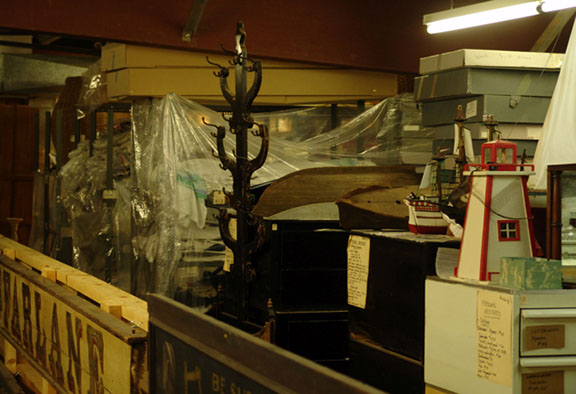
© Photo courtesy of Prince Edward Island Museum and Heritage Foundation
Figure 1. Before RE-ORG: view of main storage room, showing general overcrowding of aisles and units.
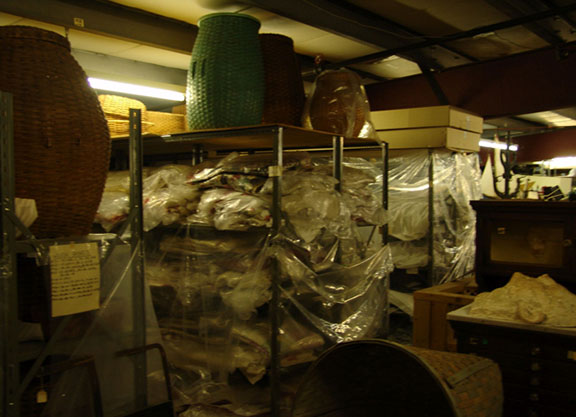
© Photo courtesy of Prince Edward Island Museum and Heritage Foundation
Figure 2. Before RE-ORG: general view of main storage room, showing how flat textiles were stored.
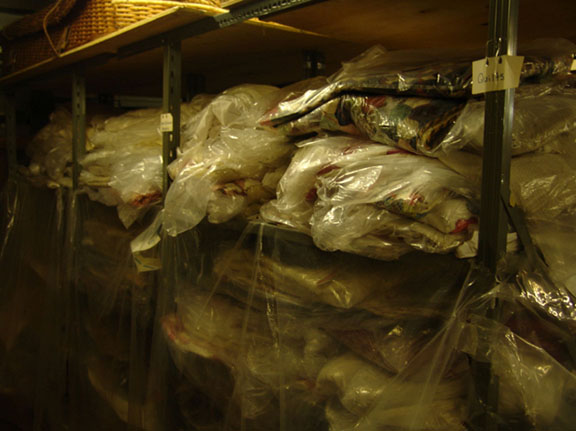
© Photo courtesy of Prince Edward Island Museum and Heritage Foundation
Figure 3. Before RE-ORG: detail of the storage of flat textiles, showing overcrowded shelves containing quilts. Visibility of the collection for inspection and accessibility is limited.
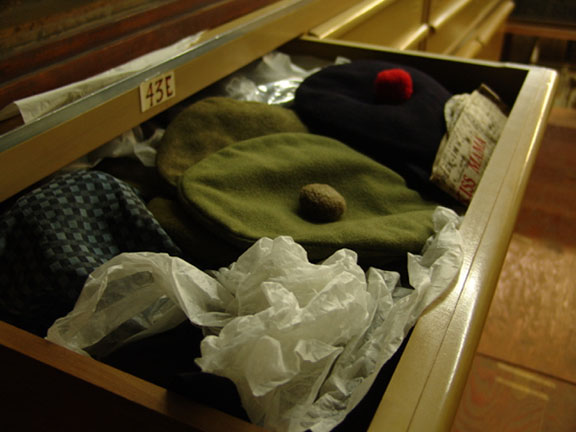
© Photo courtesy of Prince Edward Island Museum and Heritage Foundation
Figure 4. Before RE-ORG: overcrowded drawers containing hats. Safe access to the objects is difficult, and pressure on the materials can cause deformations.
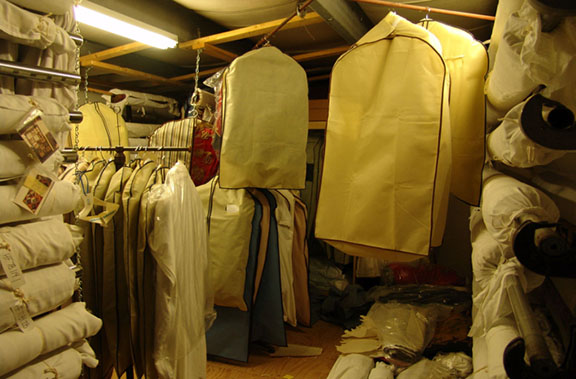
© Photo courtesy of Prince Edward Island Museum and Heritage Foundation
Figure 5. Before RE-ORG: textile storage room showing how rolled textiles and garments were placed or hung wherever space could be found.
Project details
Within a year, the PEI Museum and Heritage Foundation and CMA PEI were able to make the following storage improvements:
- They reconfigured the storage layout to improve space efficiency by
- moving and repurposing old cabinets and static shelving units,
- using pegboard to hang objects in unused vertical spaces (Figure 10) and
- constructing new banks of hanging space for textile and costume collections.
- They improved preventive conservation conditions by
- assembling and storing textiles in 50 boxes on newly acquired compact shelving units (Figures 6 and 7);
- relocating large flat textiles to a new hanging rolled textile system, utilizing an S-hook and chain method (Figures 8 and 9);
- constructing padded hangers and garment bags for costumes (such as military uniforms);
- creating textile identification tags to reduce unnecessary handling; and
- providing clear aisle access for the safe retrieval of collection items.
In summary, 197 large flat textiles and 157 drawers or boxes of textiles were rehoused. In addition, the database was updated with the new location for each item.
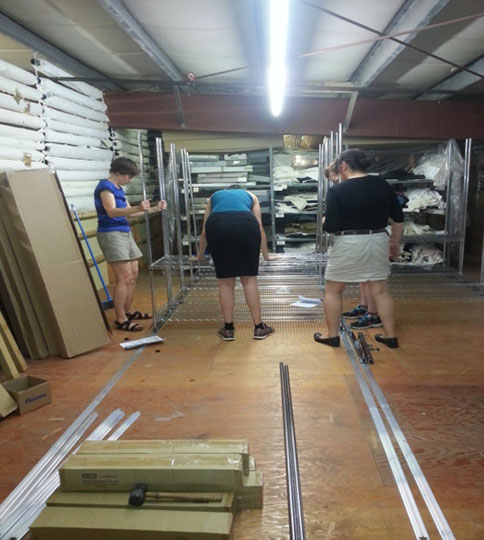
© Photo courtesy of Prince Edward Island Museum and Heritage Foundation
Figure 6. During RE-ORG: installation of new compact shelving units.

© Photo courtesy of Prince Edward Island Museum and Heritage Foundation
Figure 7. After RE-ORG: storage of textiles in boxes placed on the new compact shelving units in the main storage room.
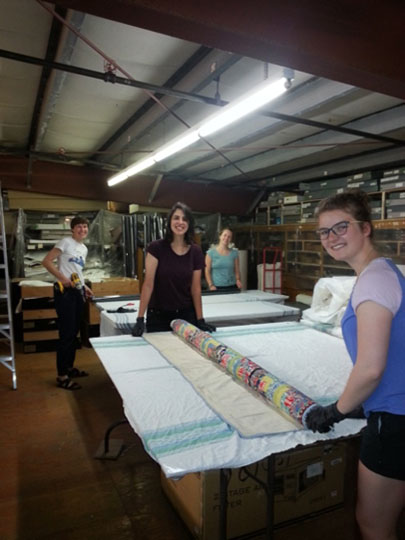
© Photo courtesy of Prince Edward Island Museum and Heritage Foundation
Figure 8. During RE-ORG: rolling flat textiles in preparation for a hanging rolled system.
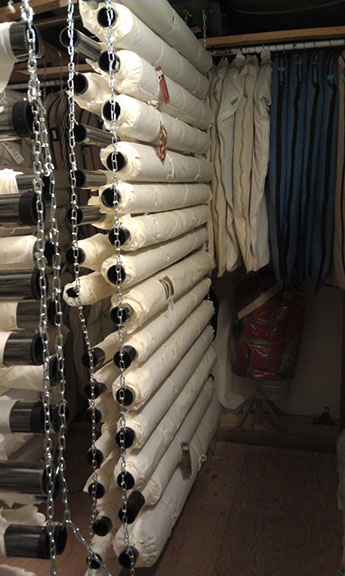
© Photo courtesy of Prince Edward Island Museum and Heritage Foundation
Figure 9. After RE-ORG: storage of rolled textiles in the textile storage room.
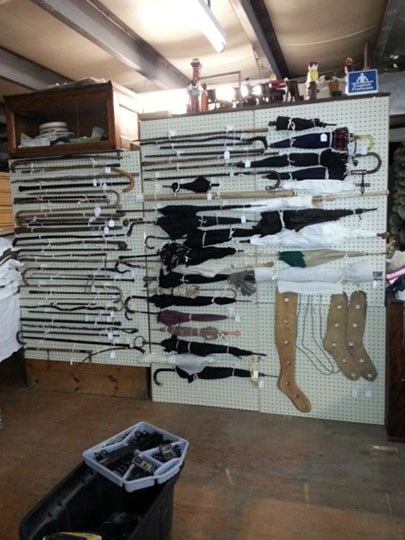
© Photo courtesy of Prince Edward Island Museum and Heritage Foundation
Figure 10. After RE-ORG: a repurposed pegboard mounted to the back of cabinets and used to store long and thin objects.
The project took 9 months to complete, with the help of no more than 4 team members during phases 1 to 3 and 7 team members during phase 4 (Table 1, Figure 11).
| RE-ORG phase | Number of weeks / months to complete | Number of team members |
|---|---|---|
| 1. Getting started | 2 weeks | 3 |
| 2. Storage condition report | 4 weeks | 3 |
| 3. Storage action plan | 6 weeks | 4 |
| 4. Storage reorganization implementation | 6 months | 7 |
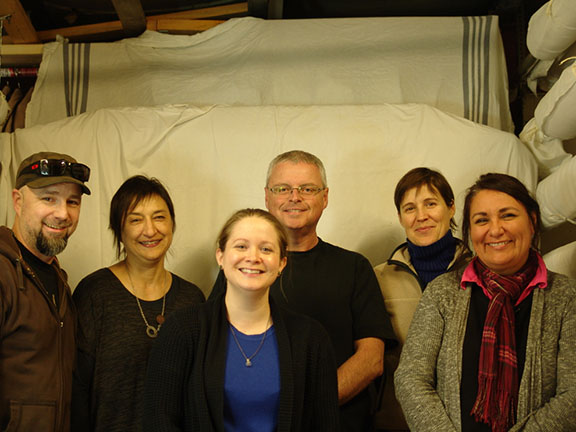
© Photo courtesy of Prince Edward Island Museum and Heritage Foundation
Figure 11. RE-ORG project team.
The RE-ORG project cost $66,580 to complete, with more than half of the budget being allocated to staff time and external services. Less than a quarter of the budget was spent on tools and storage furniture. The PEI Museum and Heritage Foundation was also successful in securing a $10,000 grant from the Museums Assistance Program for the project, as well as $12,610 from other sources.
| Budget item | Amount (CAN$) |
|---|---|
| Staff time | 26,956 |
| Tools, supplies and materials | 6,235 |
| Storage furniture | 9,363 |
| External services (such as contractors) | 24,026 |
| Total project cost | 66,580 |
Based on the RE-ORG Self-evaluation Tool for Collections in Storage (PDF Version), the PEI Museum and Heritage Foundation made improvements in all four components of RE-ORG: “management,” “building and space,” “collection” and “furniture and small equipment.”
According to the results in Table 3, the “furniture and small equipment” component experienced the largest improvement with an increase of 39% (Figure 12).
| RE-ORG component | Score (before) | Score (after) |
|---|---|---|
| Management (maximum of 42 points) | 19 | 24 |
| Building and space (maximum of 54 points) | 21 | 37 |
| Collection (maximum of 51 points) | 27 | 44 |
| Furniture and small equipment (maximum of 33 points) | 16 | 29 |
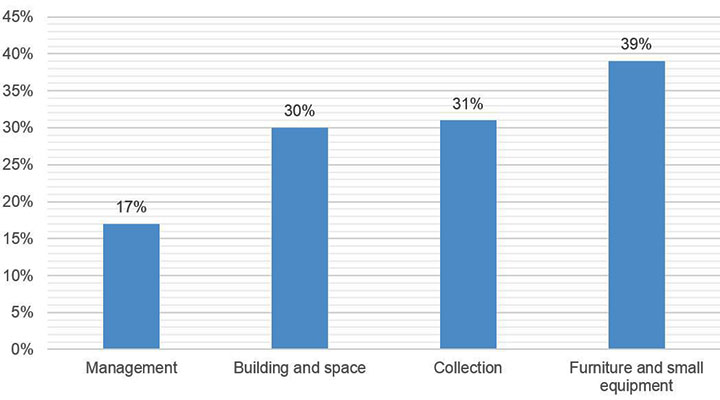
© Government of Canada, Canadian Conservation Institute. CCI 132794-0056
Figure 12. Graph illustrating the percentage of improvement to the score for the RE-ORG self-evaluation tool, calculated by comparing scores before and after the storage reorganization project.
Description of Figure 12
| RE-ORG component | Percentage of improvement |
|---|---|
| Management | 17% |
| Building and space | 30% |
| Collection | 31% |
| Furniture and small equipment | 39% |
Lessons learned
Based on the experience of the PEI Museum and Heritage Foundation, the following should be considered in future RE-ORG projects:
- Your project may take longer than anticipated due to circumstances beyond your control (such as delivery delays). Plan for extra time or adjust your project so you do not lose time.
- Assemble a great team. Build a team of individuals who are dedicated, passionate and flexible (both physically and mentally). Assign roles but recognize that this is truly a team effort. Make sure each person on your team knows what the others are doing, and tap into everyone’s skill sets.
- Plan out your work and swing space (space used temporarily to store objects being moved out of storage) wisely, or you may have to constantly recreate this space throughout the project.
- Remember to keep track of your accession numbers when repacking and rolling.
- Your action plan is not set in stone, so remain flexible and open-minded to new ideas that may save time and/or money.
- RE-ORG can be considered an ongoing project as it enables additional projects (completing an inventory, updating locations in the database, etc.).
Additional resources
- Video showing how the PEI Museum and Heritage Foundation and CMA PEI optimized their storage space using a pegboard hanging system: “Repurposing Leftover Pegboard to Store Collections (RE-ORG Canada)”
- Video of the presentation by Jason MacNeil and Lesley Caseley at the 2016 RE-ORG: Canada (Atlantic) one-day conference, “RE-ORG: Canada (Atlantic) Storage Condition Report – Prince Edward Island Museum and Heritage Foundation”
- Video about this project by Paz Carolina Tejada Urbina, who worked as a volunteer on the textile collection.
- Entries from the PEI Museum and Heritage Foundation and CMA PEI in the Collection Storage Tips & Tricks resource about
- Article entitled “P.E.I. Museum Makeover Aims to Maximize Storage Space” (CBC News, February 24, 2016) by Nancy Russel
- ICCROM web page describing the RE-ORG method